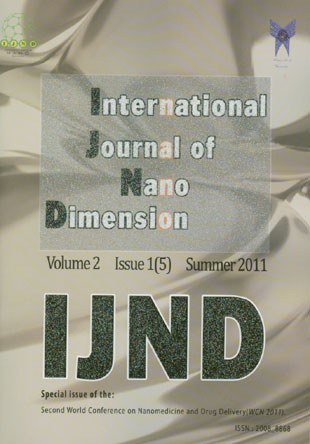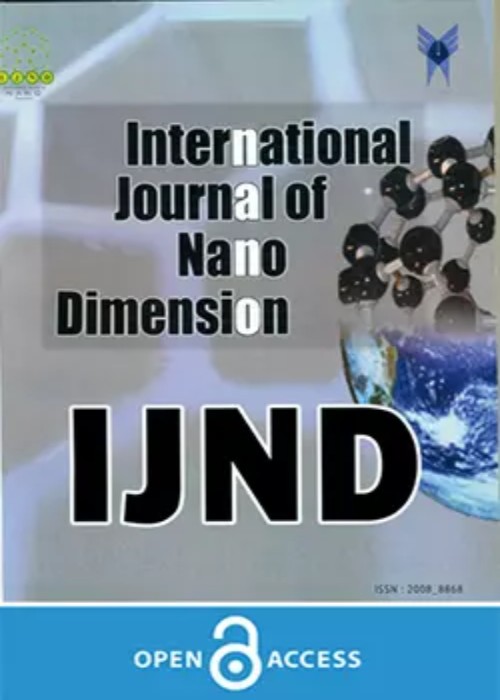فهرست مطالب

International Journal of Nano Dimension
Volume:2 Issue: 1, Summer 2011
- 96 صفحه،
- تاریخ انتشار: 1390/05/20
- تعداد عناوین: 9
-
Pages 1-15Nanotechnology has slowly but steadily revolutionized the diagnosis, imaging and treatment of cancer. Detecting cancer at earliest stages, locating the tumor at different areas in the body and specific delivery of the drugs to malignant cells including surgically inaccessible tumors are the core areas of medical and pharmaceutical research across the world. In this endeavour, Nanodevices have emerged as the most important drug delivery devices in the treatment of cancer. Nanoscale devices smaller than 50 nm, can easily enter most cells, while those smaller than 20 nm can transit out of blood vessels. Such small sizes are capable of carrying large number of small molecules in the form of a drug or a contrast agent. These devices can readily interact with biomolecules on both the cell surface and within the cell. The ability of such devices to deliver the therapeutic agents to target cells or within specific organelles is of immense potential in cancer treatment. The major areas in nanomedicine developed in cancer include:•Prevention and control - developing nanodevices to deliver the therapeutic agents and design of vaccines.•Early detection and proteomics- developing new platforms for analysis of cancer-associated markers.•Improved Diagnostics-detection of molecular changes occurring in limited number of cells with high sensitivity is another useful feature of these devices. This ensures early detection of cancer which is the most crucial step in arresting the malignant cell growth.•Imaging diagnostics- designing targeted contrast agents that improve the resolution of cancer to a single cell.•Multifunctional Therapeutics-creating therapeutic devices that can control the release of anti cancer agents and control their release in order to deliver to the targeted site only.
-
Pages 17-23Giant Unilamellar Vesicles (GUVs) consisting in self-closed lipid bilayers of 0.5-100 μm diameter are considered as oversimplified models of cells because of their biological membrane and micrometric size while Large Unilamellar Vesicles (LUVs) of 100-500 nm diameter have applications in drug delivery. To improve structural and mechanical properties of these vesicles, we have developed two categories of composite polymer-vesicles. The first category is prepared by encapsulating solutions or networks of poly (N-isopropyl-acrylamide) (polyNIPAM) chains. PolyNIPAM exhibiting a Low Critical Solution Temperature (LCST) at 32°C, composite NIPAM-vesicles are thermo-responsive. The second category of vesicles is obtained by adsorption of polyelectrolytes (chitosan or hyaluronan or both layer-by-layer) on their outer surface. Chitosan and hyaluronan are respectively positively and negatively charged polymers; both are biocompatible and allow to tune the net charge of the vesicles. All these composite vesicles hold promise as passive mechanical models of cells and as drug carriers because of their improved structural and mechanical properties and enhanced resistance to various mechanical or chemical stresses if compared to unmodified vesicles. Poly (NIPAM) vesicles present the additional advantage to be potential thermo-responsive drug carriers, collapsing reversibly at 32°C with a release of 98% of their internal solution
-
Pages 25-28Nowadays nanotechnology as a new direction of science allows us to develop therapeutic methods of the endogenous intoxication syndrome and to create a new class of biocompatible sorbents. In Ukraine first preparations of medical nanotechnology were produced and patented in 1998. These are IKBB (intracorporeal biocorrector), magnet-controlled sorbent (MCS-B), and Micromage-B. The preparations are based on colloid magnetite particles (Fe3O4) from 6 to 12 nm. Adsorption layer provides a high sorption activity to magnetite nanoparticles. Total activity of their sorption surface is 800 – 1200 m2/g, magnetic field intensity produced by each particle is 300 - 400 kA/m, ζ – potential is – 19 mV. Each magnetite particle is a subdomain elementary magnetite of a sphere shape. The main biological action of nanotechnology preparations is directed towards regulation of cell metabolism. Therapeutic effect of this preparation is based on the influence of adsorption process and of constant magnetic field that surrounds colloid magnetite particle on cellular and subcellular structures. Point of attack is surface proteins of cell membranes. Colloid magnetite particles modify composition of protein molecules thereby affecting the transport of substances to a cell. Using magnet-controlled sorbent the method of extracorporal hemocorrection on the whole is more effective and reliable way to activate natural processes of detoxication of organism, than that of artificial detoxication. The absence of contra-indication and incidental effects (haematic, haemodynamic, hormone, electrolytic, immune) creates real predisposition for using this method in intensive therapy of intoxication syndrome.
-
Pages 29-36In this paper we report an eco-friendly route for the synthesis of sliver nanoparticles using Agaricus bisporus (white button mushroom) extract. The synthesized silver nanoparticles were confirmed and characterized by UV-Visible spectrum of the aqueous solution containing silver ions showed a peak at 420 nm corresponding to the surface plasmon absorbance of silver nanoparticles. Transmission Electron Microscopy (TEM) micrographs showed the size of silver nanoparticles and were measured in the range of 8-50nm, Fourier Transform Infrared Spectroscopy (FTIR) spectrum detection of analysis showed peaks between 500-4000 cm-1 confirmed the presence of proteins, carbonyl groups, esters and carboxylic acids for the synthesis and stabilization of silver nanoparticles. X-ray diffraction (XRD) spectrum of the silver nanoparticles exhibited 2θ values corresponding to the silver nanocrystal. Further, the antibacterial activity of synthesized silver nanoparticles showed effective inhibitory activity against pathogens and non- pathogenic bacterial strains vis, Escherichia coli, Staphylococcus sps, pseudomonas sps, and Bacillus sps.
-
Pages 37-48Interpenetrating polymer networks (IPN) were formed involving hydrophobic polybutyl acrylate (PBA) and hydrophilic poly hydroxyethyl acrylate (PHEA). PBA prepolymer was first formed in presence of ferric oxide nanoparticles (<30nm) under continuous stirring through free radical polymerization. 2-Hydroxyethylacrylate monomer premixed with crosslinker and initiator was added to it and the reaction was allowed to continue till the gel was formed. The ferric oxide particles were synthesized using thermal arc plasma technique. The particles were characterized by XRD, TEM. The magnetization was determined by VSM. Magnetic response of the IPN was assured after embedment of the iron oxide particles. The signature of particle embedment in IPN gel bulk was confirmed by FTIR and SEM micrographs. Swelling study in three different pH solutions of 4, 6, 9 showed maximum swelling in alkaline pH (9). In vitro biocompatibility was tested on plant cell as well as on bacteria, E-coli. Variation in crosslink density of the IPN in presence of the iron oxide particles was tested and observed to be affecting the drug loading and/or releasing capability of the network. The drug loading and release test of the IPNs with and without iron oxide nanoparticles has been studied for multivitamins, salicylic acid and acetaminophen drugs
-
Pages 49-54The efficient detection of charged biomolecules by biosensor with appropriate semiconducting nanomaterials and with optimum device geometry has caught tremendous research interest in the present decade. Here, the performance of various label-free electronic biosensors to detect bio-molecules is investigated by simulation technique. Silicon nanowire sensor, nanosphere sensor and double gate field effect transistor (DGFET) sensor with different device parameters are reported here and their performances are compared. For the three types of sensors, radius of the nanowire, radius of the nanosphere and the silicon body thickness for the DGFET are varied to compare their selectivity, sensitivity, settling time etc. The result of adjustment of the flow of the fluid is also investigated by simulation.
-
Pages 55-60Large unilamellar liposomes and multilamellar vesicles consisting of DMPC interacted with cationic phosphorus-containing dendrimers CPDs G3 and G4. DSC and ζ -potential measurements have shown that liposomal-dendrimeric molecular recognition occurs due to the interaction between the complementary surface groups. Calorimetric studies indicate that the enthalpy of the transition of the lipids that interact with CPDs is dependent on the dendrimers generation. These results can be used in order to rationally design mixed modulatory liposomal locked-in dendrimeric, drug delivery nano systems.
-
Pages 61-65We report the direct soft chemical synthesis and characterization of a family of face centered cubic (fcc) and partially ordered face centered tetragonal (fct) FePt nanoparticles (NPs) suitable for biomedical applications. Both fcc and partially ordered fct-FePt NPs are synthesized by employing a simple polyol method. By using polyvinyl pyrolidone (PVP) as a stabilizer in various ratios during synthesis, fcc-FePt NPs have been converted into partially ordered fct-FePt NPs at low temperature (300˚C). The advantages of this process are its simplicity, the short reaction time, easy preparation and dispersibility of the NPs in aqueous media.
-
Pages 67-84Patient noncompliance to current tuberculosis (TB) therapy owing to multidrug administration daily leads to treatment failure and emergence of multidrug resistant and extensively drug resistant TB. To avoid the daily dosing, application of nanotechnology is the only viable solution by virtue of sustained release of drugs. Other potential advantages of the system include the possibility of selecting various routes of dosing, reduction in drug dosage/adverse effects/drug interactions, targeting drug resistant and latent bacteria etc. Plenty of work has been done in animal models of TB to support the notion that nanomedicine provides a ray of hope to encounter TB effectively; certain crucial questions are yet to be addressed.


